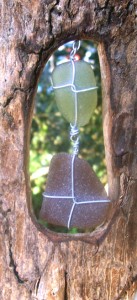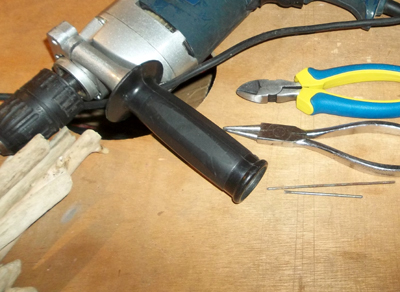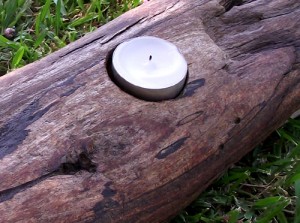You’ll need some tools for woodcraft with driftwood. Working with driftwood is very different to working with wood bought from a store because driftwood has usually not been machined in any way.

driftwood and sea glass mobile
Before getting creative or expressing your inner artist with driftwood woodcraft the wood needs to be cleaned and prepared.
The tools you use for your driftwood crafts can be as simple, or as elaborate as you like, but there are certain basic tools you may need or may like to use.
Woodcraft with Driftwood
– What You Need to Start Working With Driftwood
Here is our list of recommended tools for working with driftwood:

drill, cutters, circular pliers and drill bits
A drilling machine. A hand drill will work, but an electric machine is better. A standard 12mm drill is fine.
A collection of drill bits. We use several sizes of drill bits, and we have a collection of twist bits, home-made bits, spade bits, and hole saws. The home made bits are for special purposes, such as drilling a hole that is deeper than can be made with a standard bit. Flattened and sharpened bicycle spokes make great bits for smaller diameter holes.
A sharp knife is always useful.
For joining driftwood we prefer to not use metal fasteners – instead we use dowelled and glued joints. Simply drill a hole into the wood, squeeze some glue – wood glue, epoxy glue, or cascamite – into the hole, and force a dowel plug into the hole. Leave to dry, trim off the excess, and sand the dowel down to the level of the surrounding area.
Dowel Plugs. When preparing dowels score the dowel with a knife or hack saw blade in the length of the dowel. This is so that excess glue can escape from the hole. If the glue cannot escape the dowel will not go all the way in, and a weak joint will be formed. We use mostly 6mm wooden dowels, and bamboo sosatie sticks for dowelling.
Pliers and Wire Cutters. Because we occasionally use wire as a part of our projects, pliers and wire cutters are essential.
Hammers. A standard hammer is fine for general knocking and banging – we have however made a light-weight wooden mallet for driving in dowel pegs. The little mallet drives the dowels in easily, without shattering or breaking the dowels.
Abrasives. We use a range of abrasives – from 80grit up to 600grit. The degree of sanding depends on the woodcraft project or craft item. Some driftwood pieces will not be finished at all, some will receive a brief sanding, and others will be sanded down in several grades.

driftwood votive candle holder
In our opinion this is the bare minimum of tools required for driftwood crafts. You may be happy with less, or you may want more – the final decision on tools needed for woodcraft with driftwood are with the crafting artisan. We cannot tell you how to work with driftwood, but we can tell you how we do it.
© Copyright Tony Flanigan 2014
